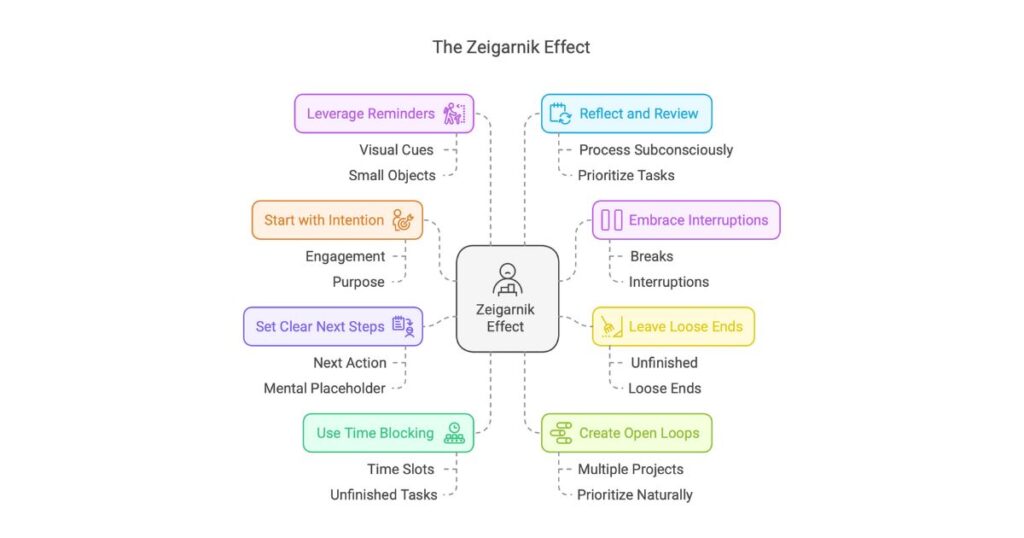Ever had a task you couldn’t stop thinking about, even after you’ve stepped away from it? Or maybe you’ve felt that annoying tug of something unfinished, like it’s stuck in the back of your mind? That’s the Zeigarnik Effect in action. It’s a psychological quirk that can actually help you get more done and grow in ways you might not expect. Let’s take a closer look at how it works and how you can use it to your advantage.
Why to Use This Tool
Imagine having a mental to-do list that practically writes itself, effortlessly reminding you of important tasks without the need for constant note-taking. Sounds too good to be true, right? Well, that’s precisely what the Zeigarnik Effect offers!This powerful cognitive quirk can help you:
- Boost your memory and recall for unfinished tasks
- Increase motivation to complete projects
- Reduce procrastination by leveraging your brain’s natural tendencies
- Enhance focus and concentration on important goals
Who wouldn’t want their own personal mental assistant, gently nudging them towards success? The Zeigarnik Effect is like having a built-in productivity coach, always ready to keep you on track.
How to Use This Tool
Ready to harness the power of the Zeigarnik Effect? Here’s your step-by-step guide to putting this psychological superpower to work:
- Start with intention: Begin a task or project with clear focus and purpose. The more engaged you are at the start, the stronger the Zeigarnik Effect will be.
- Embrace interruptions: Don’t fear breaks or interruptions. In fact, strategically pausing your work can amplify the effect.
- Leave loose ends: When you take a break, resist the urge to tie up every loose end. Leave some aspects of your task deliberately unfinished.
- Set clear next steps: Before stepping away, identify the next action you’ll take when you return. This creates a mental placeholder.
- Use time blocking: Allocate specific time slots for tasks, but don’t always finish within those blocks. The unfinished nature will keep your mind engaged.
- Create open loops: Start multiple projects or tasks simultaneously, allowing your brain to juggle and prioritize them naturally.
- Leverage reminders: Use visual cues or small objects to represent unfinished tasks, amplifying the mental effect.
- Reflect and review: Regularly revisit your open tasks, allowing your mind to process and prioritize them subconsciously.
Real-life Implementation
Sarah, a marketing executive, always felt buried under her never-ending to-do list. One day, she came across the Zeigarnik Effect and decided to test it out.
She started with a tough project proposal. Instead of forcing herself to finish it all at once, she worked on it for 45 minutes, then took a deliberate break to grab coffee. Surprisingly, ideas for the proposal kept coming to her throughout the day.
Seeing how well it worked, Sarah began using the same approach with other tasks. She’d start an email, leave it halfway done, and switch to something else. Later, she’d come back to it, finding it easier to finish with fresh energy.
Within a few weeks, Sarah noticed a big shift. She was getting more done, felt less overwhelmed, and had a better handle on her workload. Those lingering mental nudges helped her stay on top of priorities, and she procrastinated far less. By tapping into the Zeigarnik Effect, Sarah went from feeling constantly stressed to becoming more productive and in control.
Template Framework
Ready to put the Zeigarnik Effect into action? Here’s a simple template to get you started:
Task Initiation:
- Task Name: _______________
- Start Time: _______________
- Initial Action Taken: _______________
Strategic Interruption:
- Interruption Time: _______________
- Next Planned Action: _______________
Mental Check-ins:
- How often did the task come to mind? _______________
- Any new ideas or insights? _______________
Task Completion:
- Completion Time: _______________
- Ease of Returning to Task (1-10): _______________
Reflection:
- How did using the Zeigarnik Effect impact your focus and productivity?
- What adjustments can you make for next time?
History of the Tool
But where did this idea come from? Let’s take a step back in time.
It’s the 1920s in Berlin. A group of psychologists, including a young researcher named Bluma Zeigarnik, are out for dinner at a local restaurant. As they eat and talk, Zeigarnik notices something interesting about their waiter. He’s able to remember detailed orders without writing them down.
Curious, she pays closer attention and realizes the waiter’s memory isn’t extraordinary—it’s tied to the task at hand. Once an order is finished and paid for, the details seem to slip away from his mind.
This observation led Zeigarnik to conduct a series of experiments, which eventually revealed what we now call the Zeigarnik Effect. She discovered that people tend to remember unfinished tasks more clearly than completed ones. It’s like our brains have a natural reminder system for things we haven’t finished.
Since then, the Zeigarnik Effect has been explored and used in many areas, from psychology to marketing. It’s a great example of how a simple observation—like noticing a waiter’s memory—can lead to deeper insights about how our minds work.
So, the next time you can’t stop thinking about something you haven’t finished, think of Bluma Zeigarnik and that Berlin restaurant. It’s not just procrastination—it’s a fascinating part of how we’re wired.
Tools You Might Also Like:
- The 2-Minute Rule: A Simple Tool for Greater Productivity
- The Eisenhower Matrix: A Simple Tool for Better Time Management
- The Ivy Lee Method: A Simple Way to Boost Your Productivity
- The 80/20 Rule: Unlocking More with Less Effort
- The Pomodoro Technique: A Simple Tool to Boost Your Productivity
- The Seinfeld Strategy: Building Habits with Consistency
